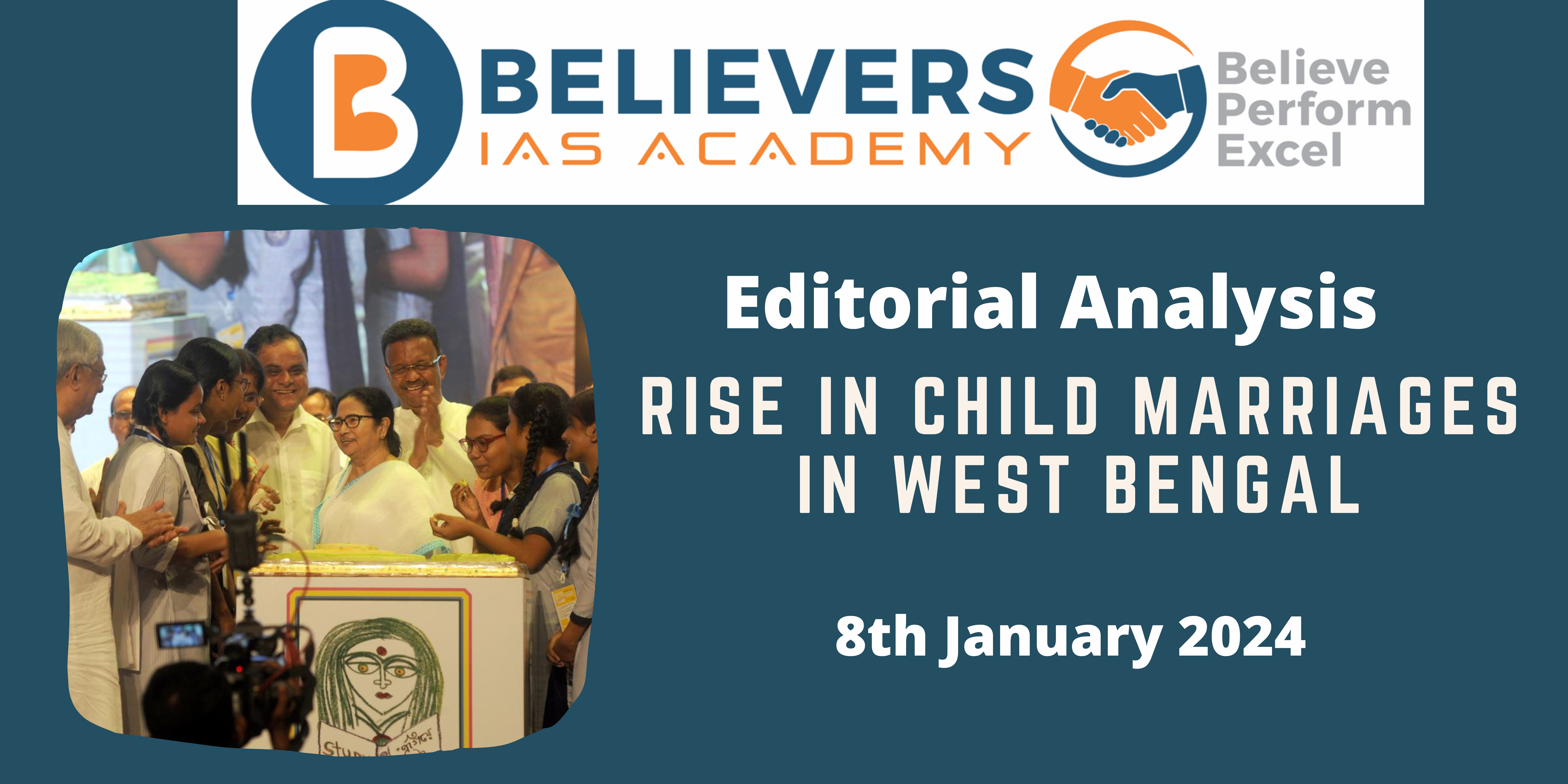Rise in child marriages in West Bengal
Context:
Child marriage persists in India despite education initiatives, and a recent Lancet study reveals a surge in West Bengal, Bihar, Uttar Pradesh, and Maharashtra. While policy interventions like the Kanyashree Prakalpa scheme aim to deter early marriages, a disconnection between educational strides and child marriage rates raises concerns, particularly in economically deprived areas like Murshidabad. This analysis delves into the Lancet findings, impact on maternal health, policy interventions, and the need for a comprehensive approach in combating child marriage.
Relevance:
GS – 02 (Judiciary, Issues Related to Children, Issues Related to Women, Gender, Government Policies & Interventions)
Prelims:
Raising Legal Age of Marriage for Women, Child Marriage, Jaya Jaitly Committee, Protection of Children From Sexual Offences (POCSO) Act, Prohibition of Child Marriage Act (PCMA), 2006, International Conventions Related to Child Marriage.
Mains question:
Examine the revelations on the surge of child marriages in West Bengal despite educational initiatives, and propose a comprehensive strategy involving policy reforms, community engagement, and legal frameworks to address this persistent societal challenge. (250 words)
Dimensions of the Article:
- Child Marriage Trends
- Kanyashree Prakalpa scheme
- Challenges in Implementation and Legal Framework
Child Marriage Trends:
- The Lancet study highlights a national decline in child marriages but emphasizes concerning spikes in West Bengal, questioning the efficacy of current policies.
- Despite initiatives like Kanyashree Prakalpa, the state witnesses a significant rise, warranting a deeper examination of the socio-economic factors contributing to this trend.
- Impact on Maternal Health: Child marriage’s adverse effects on maternal and child health become starkly evident in places like Murshidabad, where a recent spate of infant deaths is linked to low birth weight, a consequence of early marriages.
- The connection between social problems, poverty, and healthcare challenges calls for a holistic approach to address the root causes.
Kanyashree Prakalpa scheme:
- Kanyashree, an initiative by the Government of West Bengal, aims to enhance the lives and status of girls hailing from economically disadvantaged families.
- The program provides financial assistance to these families to deter them from arranging marriages for their daughters before the age of eighteen, a practice often driven by economic constraints.
- The primary objective is to empower girls from impoverished backgrounds who face challenges pursuing higher education due to harsh economic conditions.
- The initiative has earned global recognition, endorsed by the United Nations Department of International Development and UNICEF.
- The scheme encompasses two key components:
- An annual scholarship of Rs. 1000.00
- A one-time grant of Rs. 25,000.00
- The annual scholarship is specifically tailored for unmarried girls aged 13–18 years enrolled in classes VIII-XII, either in government-recognized regular schools or equivalent open schools, as well as those pursuing vocational/technical training courses.
- The recent removal of income barriers by the Government of West Bengal allows every girl to apply for this scheme, broadening its accessibility.
Challenges in Implementation and Legal Framework:
- The enforcement of laws against child marriage faces challenges in West Bengal, as revealed by the low number of cases registered under The Prohibition of Child Marriage Act (PCMA), 2006, compared to states with smaller populations.
- The Ministry of Women and Child Development’s data points to gaps in implementing existing laws.
- The introduction of the Prohibition of Child Marriage (Amendment) Bill, 2021, seeks to raise the marriage age for women, reflecting a recognition of the need for legal reforms.
Way Forward:
- Addressing the child marriage challenge in West Bengal necessitates a comprehensive strategy. While existing policies have made strides, a closer integration of social campaigns involving local communities, schools, and panchayats is essential.
- Creating awareness, fostering political will, and enforcing legal frameworks should align to tackle this deep-rooted societal issue. The district action plan initiated in 2022 should evolve into a collaborative effort involving stakeholders at all levels.




